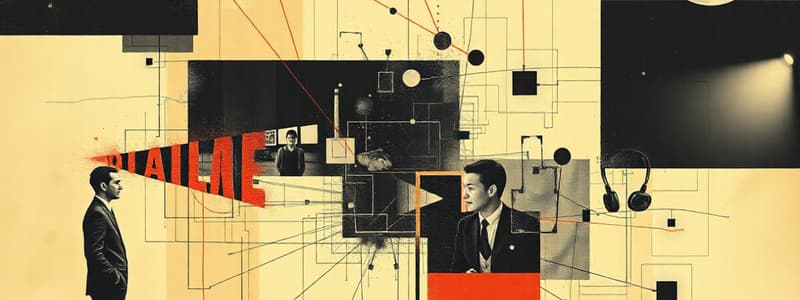Podcast
Questions and Answers
Which type of noise arises from the actual words used in communication?
Which type of noise arises from the actual words used in communication?
- Semantic Noise (correct)
- Psychological Noise
- Physical Noise
- Physiological Noise
Why are social systems important in the context of communication models?
Why are social systems important in the context of communication models?
- They establish rules that hinder communication.
- They are irrelevant to the communication process.
- They shape the context in which communication occurs. (correct)
- They provide structure to the sender-receiver model.
What type of noise involves external environmental factors affecting communication?
What type of noise involves external environmental factors affecting communication?
- Physical Noise (correct)
- Physiological Noise
- Psychological Noise
- Semantic Noise
Which type of noise deals with internal thoughts and biases that affect communication?
Which type of noise deals with internal thoughts and biases that affect communication?
In which model do communication processes occur simultaneously?
In which model do communication processes occur simultaneously?
What is the primary role of theoretical models in understanding communication?
What is the primary role of theoretical models in understanding communication?
What type of noise arises specifically from the words being used in communication?
What type of noise arises specifically from the words being used in communication?
What is the primary focus of models in communication?
What is the primary focus of models in communication?
Which type of noise specifically pertains to one's understanding of language?
Which type of noise specifically pertains to one's understanding of language?
In which model does communication occur without a clear sender-receiver distinction?
In which model does communication occur without a clear sender-receiver distinction?
Which aspect of noise includes cognitive distractions such as thoughts and biases?
Which aspect of noise includes cognitive distractions such as thoughts and biases?
What element is included in the Interaction Model of communication?
What element is included in the Interaction Model of communication?
What does the self-serving bias involve regarding positive behaviors?
What does the self-serving bias involve regarding positive behaviors?
How do we typically perceive others' negative behaviors according to the fundamental attribution error?
How do we typically perceive others' negative behaviors according to the fundamental attribution error?
Which of the following is a component that influences perception?
Which of the following is a component that influences perception?
What is implicit personality theory?
What is implicit personality theory?
What aspect of perception involves selecting, organizing, and interpreting stimuli?
What aspect of perception involves selecting, organizing, and interpreting stimuli?
Which statement best describes how language affects perception?
Which statement best describes how language affects perception?
In how do we typically describe our negative behaviors?
In how do we typically describe our negative behaviors?
Which factor can affect our cognitive ability and perception?
Which factor can affect our cognitive ability and perception?
What is the fundamental attribution error primarily concerned with?
What is the fundamental attribution error primarily concerned with?
Which statement accurately reflects the concept of stability in attribution?
Which statement accurately reflects the concept of stability in attribution?
What is the first step of the perception process?
What is the first step of the perception process?
Which of the following best describes 'prototypes' in the context of organization in perception?
Which of the following best describes 'prototypes' in the context of organization in perception?
What can limit our perception according to personal constructs?
What can limit our perception according to personal constructs?
What are stereotypes in the perception process?
What are stereotypes in the perception process?
In the interpretation step, what does 'locus' refer to?
In the interpretation step, what does 'locus' refer to?
What role does context play in the selection step of perception?
What role does context play in the selection step of perception?
Scripts in the organization of perception refer to what?
Scripts in the organization of perception refer to what?
Which of the following is an example of how culture affects perception?
Which of the following is an example of how culture affects perception?
What is a key characteristic of having flexible stereotypes?
What is a key characteristic of having flexible stereotypes?
What can be a result of using rigid constructs in perception?
What can be a result of using rigid constructs in perception?
Flashcards are hidden until you start studying
Study Notes
Theoretical Models
- Theoretical models are used to make abstract concepts more concrete and tangible.
- Models are used to analyze and understand communication, not for direct communication.
- Models help explain and predict communication patterns.
Types of Noise
- Physical Noise: External factors such as environmental distractions.
- Physiological Noise: Internal factors like physical discomfort or illness.
- Psychological Noise: Internal distractions such as thoughts, biases, or emotions.
- Semantic Noise: Misunderstandings due to different meanings or interpretations of words.
Interaction Model
- The Interaction Model incorporates context in its analysis of communication.
Transactional Model
- The Transactional Model emphasizes the simultaneous nature of communication.
- Senders and receivers are constantly exchanging messages and interpreting meaning simultaneously.
- Communication is a dynamic process, with no clear distinction between sender and receiver.
Social Systems
- All communication occurs within a broader social system.
- Societal norms, cultural values, and power dynamics influence communication.
Theoretical Models
- Used to make abstract concepts more concrete
- Help understand, explain, and predict communication
Noise
- Physical Noise: Environmental distractions
- Physiological Noise: Body's condition (illness, fatigue)
- Psychological Noise: Thoughts and biases
- Semantic Noise: The meaning of words themselves
Interaction Model
- Includes context
- Emphasizes the back-and-forth nature of communication
Transactional Model
- Captures the simultaneous nature of communication
Social Systems
- All communication happens within social systems
Theoretical Models
- Theoretical models help to understand abstract concepts by making them tangible.
- Models are used to understand, explain, and predict communication, not for communication itself.
Noise
- Physical Noise: External factors in the environment that interfere with communication (e.g., loud noises, distractions).
- Physiological Noise: Internal factors related to the sender's or receiver's physical state (e.g., hunger, illness, fatigue).
- Psychological Noise: Internal factors related to the sender's or receiver's mental state (e.g., stress, anxiety, biases).
- Semantic Noise: Misunderstandings that arise from the meaning of words (e.g., different interpretations, jargon, unfamiliar language).
Interaction Model
- The Interaction model considers the context in which communication occurs.
Transactional Model
- The Transactional model emphasizes the simultaneous nature of communication.
- Both the sender and receiver are actively involved in the communication process at the same time.
Social Systems
- All communication takes place within social systems, meaning communication is influenced by social structures, norms, and relationships.
Perception Process
- Perception is an active process of creating meaning by selecting, organizing, and interpreting people, objects, events, situations, and other phenomena.
- The perception process involves three steps that often happen simultaneously: selection, organization, and interpretation.
Selection
- Selection involves giving our attention to stimuli.
- Things that stand out, indicate (noticing things we didn't notice before because we have new knowledge, skills, experiences, etc.), and fit our current needs, desires, and cultural perspectives influence what we select to perceive.
Organization
- We organize and interpret experiences by applying schemata:
- Prototypes are ideal examples.
- Personal constructs are categories or bipolar dimensions that we use to define people and things.
- Stereotypes are generalizations about people and situations that allow us to create a set of expected behaviors.
- Scripts are sequences of behaviors that we have for how we and others should act in a particular situation.
Interpretation
- Interpretation involves attributing causes to behavior:
- Locus refers to whether the behavior is internally motivated or externally motivated.
- Stability refers to whether the behavior is stable or unstable over time.
- Specificity refers to whether the behavior is global or specific to a particular situation.
- Responsibility refers to whether the behavior is within personal control or beyond personal control.
Attribution Errors
- Self-serving bias: We often describe our positive behaviors as being internally motivated, stable, global, and within our control. Conversely, we attribute our negative behaviors to external factors, instability, specificity, and lack of control.
- Fundamental attribution error (focuses on negative behaviors and locus):
- We tend to overestimate the role of internal causes for others' negative behaviors while underestimating external causes.
- We tend to underestimate internal causes for our own negative behaviors and overestimate external causes.
Influences on Perception
- Perception is influenced by factors such as physiology, expectations, age, culture, cognitive ability, and self.
- Implicit personality theory refers to assumptions about how various qualities fit together in personalities.
Perception is Interactive
- Selection, organization, and interpretation are interactive processes. What we select to perceive influences how we organize and interpret stimuli.
- Language affects perception, and perception influences our language.
Studying That Suits You
Use AI to generate personalized quizzes and flashcards to suit your learning preferences.




